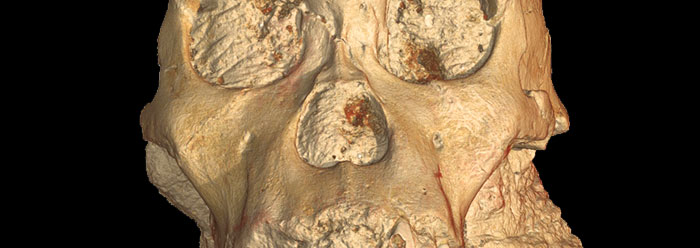Evolution's search for the "missing link" between man and ape has a long and troubled history. Australopithecus sediba is the latest fossil find that is claimed to represent evolutionary human ancestors. But the remains of this extinct ape provide several solid clues that contradict any evolutionary relationship to man.
First, the remains were dated at 1.9 million years, which is at least one million years younger than evolutionary ages assigned to some fully human remains.1 If Au. sediba really were an ancestor to man, then its kind would have morphed into mankind and ought therefore not exist (as man's ancestor) after mankind had already arrived on the scene.2 Fossil ages from both species overlap considerably according to standard dates, thus failing to line up chronologically with an evolutionary scenario.
As with Ardipithecus ramidus ("Ardi"), another celebrated "human ancestor" presented last fall, the claim for Au. sediba is that its hip structure is oriented more like a human's and that it therefore could have walked somewhat like modern man. Supposedly, it was in a state of transitioning toward the distinct human gait, a specialized mode of locomotion recently referred to as the "economical extended limb bipedalism of humans."3
Just a few months ago, anthropologist C. Owen Lovejoy promoted Ardi as an ape who walked upright.4 But to William Jungers of Stony Brook University Medical Center--who, like the rest of the world, was only able to review the evidence after Ardi had already been proclaimed a walker in the publication of its initial study--the reconstructed skeleton "really doesn't show any adaptations for bipedalism at all."5
Paleoanthropologist Lee Berger, lead author of an Australopithecus sediba study in a recent issue of Science, similarly claimed that it could have walked.6 But in neither A. ramidus' nor Au sediba's remains were found the relevant hip bones to even make such a determination!7 Therefore, it will not be surprising when Au. sediba is eventually described as having no adaptations for upright walking.
Like today's known apes, both Ardi and Au. sediba had hands for feet. Supposedly, the new find's feet had not yet advanced to the human form, as "the foot skeleton is more primitive overall."6 But how is it possible that the ape-footed Au. sediba still existed 1.9 million years ago as man's ancestor when, according to evolution, other "human ancestors" had already acquired human-like feet and walking patterns almost 2 million years earlier?3
Another stunningly irreconcilable difference between the data and the evolutionary story comes from the European Synchrotron Radiation Facility in France. In February 2010, the most complete of the two Au. sediba skull fossils was analyzed there. Berger submitted the skull to a specialized technique using synchrotron light that provided internal images without breaking open the debris-filled fossil.
The researchers found "hints of a potential brain remnant," as well as "what could be fossilised [sic] insect eggs."8 Apparently, the Au. sediba's remains had mostly rotted before being finally preserved, possibly by a catastrophic cave ceiling collapse. Darryl de Ruiter, Texas A&M University professor and Berger's colleague on the study, told Discovery News, "When I first saw the skeletons, I knew we had something special. Both were remarkably complete and extremely well preserved."9
For such soft samples as brains and insect eggs to have been preserved for thousands of years would be "special" enough, considering how quickly such organic materials decay. But to expect someone to believe that brain tissue escaped decay for 1.9 million years is asking far too much. It would be like expecting someone to believe that Au. sediba was man's ancestor--even though its skeleton was entirely ape-like and it supposedly lived long after its own descendants.
References
- A revealing chart with compiled evolutionary dates of early-man candidates reveals that they were all contemporaries. See Lubenow, M. L. 2004. Bones of Contention, Revised and Updated. Grand Rapids, MI: Baker Books, 337.
- This out-of-place date brings the proposition that Au sediba is man’s ancestor into the realm of faith. To keep this view, an evolutionist must choose to believe, with no evidentiary support, in millions of years of earth history, that Au sediba actually existed at least a couple million years before its current fossil emplacement, and that at least some in its population were able to transmutate into humans. As it stands now, with bona fide Homo remains evolutionarily dated as far older than these apes, it is more reasonable under the evolutionary view that these Au sediba remains, if related to anything, were a population that devolved from some ancient man-like form.
- Raichlen, D. A. et al. 2010. Laetoli Footprints Preserve Earliest Direct Evidence of Human-Like Bipedal Biomechanics. PLoS One. 5 (3): e9769.
- See Lovejoy, C. O. 2009. Reexamining Human Origins in Light of Ardipithecus ramidus. Science. 326 (5949): 74e1.
- Harmon, K. How Humanlike was "Ardi"? Scientific American. Posted on scientificamerican.com November 19, 2009, accessed November 25, 2009.
- Berger, L. R. et al. 2010. Australopithecus sediba: A New Species of Homo-like Australopith from South Africa. Science. 328 (5975): 195-204.
- See Thomas, B. 2009. Did Humans Evolve from 'Ardi'? Acts & Facts. 38 (11): 8-9.
- First studies of fossil of new human ancestor take place at the ESRF. European Synchrotron Radiation Facility press release, April 12, 2010.
- Viegas, J. Brain Parts Found in Ancient Human Ancestor. Discovery News. Posted on news.discovery.com April 12, 2010, accessed April 12, 2010.
* Mr. Thomas is Science Writer at the Institute for Creation Research.
Article posted on April 15, 2010.














